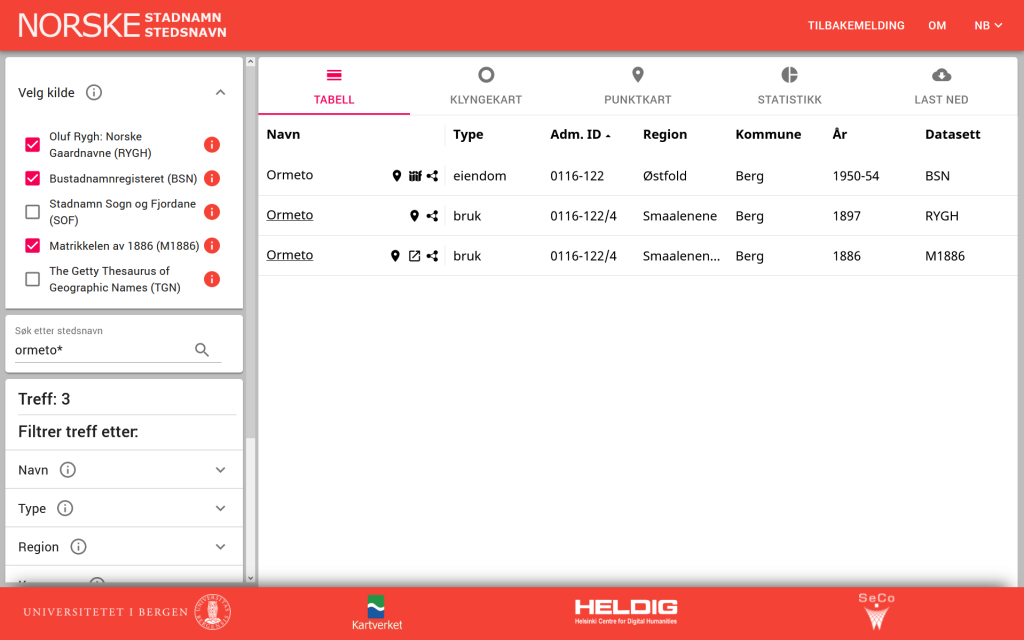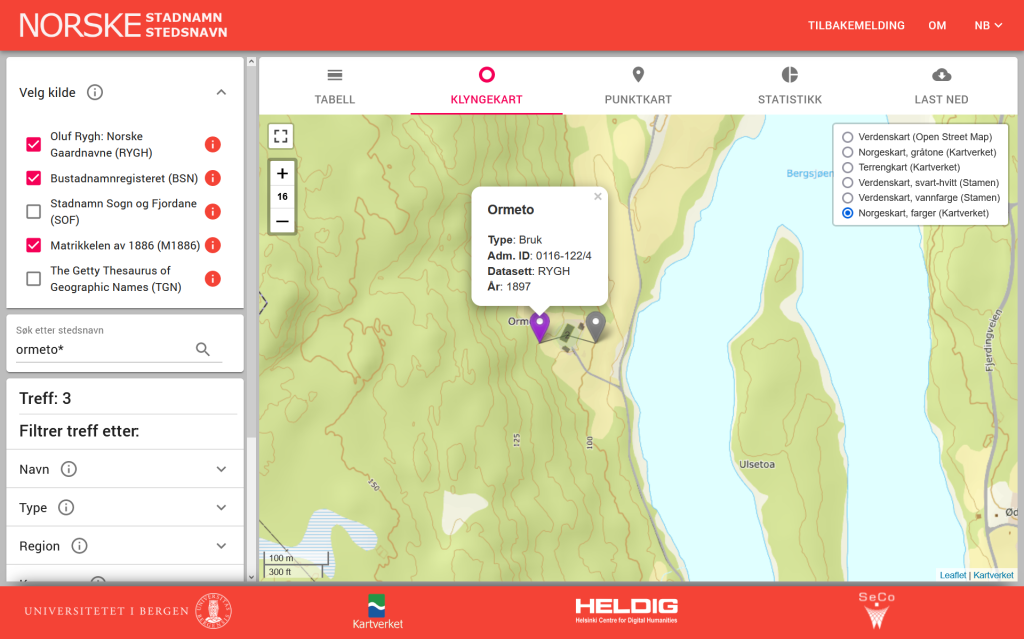by Peder Gammeltoft, Rikke Steenholt Olesen, Krister Vasshus & Alexandra Petrulevich
The Nordic Onomastics community gathered in Bergen, Norway, to celebrate the 100th birthday of the Norwegian Place-Name Archive. The two-day conference that took place on October 28–29 2021 explored a variety of topics including digitization of place-name collections and place-name databases, collection, preservation and standardization of place-names, etymological and socio-onomastic place-name research and more. Most importantly, however, the conference as a whole functioned as a large plenum discussion of the future of onomastic research in Norway and the other Nordic countries.
Highlights from the Conference Talks
The major themes of the conference were digitization of place-name collections, name collection and processing as well as standardization of place-names. The first keynote illuminated the challenges associated with digital reproduction of analogue archive structures in the early 1990s and encouraged creative thinking when it comes to place-name data models (A. Petrulevich). The completely new database for Norwegian place-names, Norske stedsnavn | Norske stadnamn, launched a few hours before the conference, was presented (P. Gammeltoft, see below for details). Likewise, the much desired digitization of Sámi place-name collection was the focus of K. Rautio Helander’s talk. Name collection and processing was illuminated in the talks on the church’s role in recording local place-names in Falckarp in Scania (O. Svensson) and a recent initiative to digitally record local place-names in Norway (C.-E. Ore). Challenges associated with current and historical regulations of place-name standardization and use as well as local inhabitants’ understanding of correct spelling of place-names in a national setting without formal legislation were discussed by T. Larsen and R. Steenholt Olesen respectively.
Etymological and socio-onomastic research on place-names as well as the future of onomastics in the Nordic countries were likewise central topics of the conference. The second keynote dealt with urban name use related to a shopping center in Helsinki, Finland, and the aspects of name use and variation in urban contexts (T. Ainiala). Political perspectives on place-name use—be it historical studies of street names or practices of standardization or mapping in the present-day or early modern context—were highlighted by O.-J. Johannesen, I. Nordland and S. Evemalm-Graham. Three talks were devoted to etymological questions concerning specific place-names or place-name types, e.g. names ending in –sete or prepositional place-names (B. Eggert, S. Mascetti, E. Heide). Finally, B. Helleland delved deep into the history of the Norwegian place-name archive; the future of the archive was deemed brighter than before since the preservation of the collection and archive research is now an institutional priority.
New Database of Norwegian Place-names
On the first day of the centenary conference, the new place-name resource, Norske stedsnavn | Norske stadnamn, was presented. Norske stadnamn | Norske stedsnavn is an open-data web-semantic database for searching, viewing and downloading place-name datasets of various kinds. The resource is structured in such a way that data are uploaded and made available dataset by dataset. For the sake of usability, each dataset may be added or omitted from the search and it is possible to search in several datasets at once.
The search is structured as a simple search, but with the possibility of filtering the search result according to the parameters shown in the table view.

It is possible to search also with wildcards, * (multiple characters) and ? (a single character), and a search like helleb?st* yields a result of 21 in four of the five current datasets chosen. Underlined place-names in the search result are linked to their source, either a book digitisation, such as RYGH (Norske Gaardnavne), the digital resource of the source, like the cadastre M1886 (Matrikkelen av 1886). Some datasets are based on digitised paper slip archives, like the BSN (Bustadnamnregisteret) and the scanned paper slip is available as an image, clickable on the little ‘iiif’ icon on the right. The point icon to the right indicates that the place-name has coordinates (see map view below) and the icon with a square with an arrow will take you to an additional resource related to the entry, for instance modern cadastral information. The far right symbol shows that the entry is available in RDF-format and clicking it shows which other information the entry is linked with.
The search result can also be shown as map results, either in the form of a cluster map or a regular point map. Each point appears as a pop-up on click and allows you to view and query its source data, as well as additional information—just like in the table view.

The resource will be continuously improved over the next few years. More datasets will be made available as they become ready, as will the search refined to include other types of searches. Data filtering and viewing will also be improved.
Future of Norwegian and Scandinavian Onomastics
Several thoughts and ideas on how to secure a future for name studies in Scandinavia were discussed during the conference. One of these thoughts was to increase interdisciplinary collaboration. This interdisciplinarity has long roots in Nordic onomastic tradition, as archaeologists and historians were also toponomysts in the early days of the discipline. Expanding the collaboration with other fields of research, such as sociology, anthropology, literary studies, geography, and economics (among others), in addition to strengthening the cooperation that already exists between toponomysts and archaeologists, historians and religious scholars, has several advantages. It will help our discipline develop methods and gain new knowledge, and it will show the relevance of onomastics for the broader academic world. To facilitate this, we should more actively invite scholars from other fields of research to workshops and seminars where we can bring our heads together and bring new ideas to the table.
Another way forward could be to tap further into the knowledge, hobbies and interests of the general public. Cooperation between hobby metal detectorists, archaeologists and toponomysts has resulted in new archaeological finds in Denmark, and will likely do the same if we made similar cooperation elsewhere. The continued recording of names in archives is an ongoing process in which we as name-scholars rely on contribution by the public. At the moment, at least in the current Norwegian solution, we need a better recruitment of volunteers. This could be done by promoting onomastics and crowd-sourced name projects in more technologically updated ways, for instance via social media and blogs as New trends in Nordic Socio-onomastics blog or Københavns gader.
Finally, there is no way for an academic discipline to survive if there is no teaching at academic institutions at both bachelor’s and master’s level. Courses in onomastics do lead to actual jobs with place-names or personal names at above all archives, mapping and cadastre authorities and language authorities in the Nordic countries. There is a need for onomastic competence and there is definitely a need for trained onomasticians to conduct onomastic research. Since some countries, most importantly here Norway, lack academic courses in onomastics altogether, we should be thinking outside the box and—through collaborations within NORNA and/or ICOS—possibly create a Nordic or international course on names for a broader range of students.
